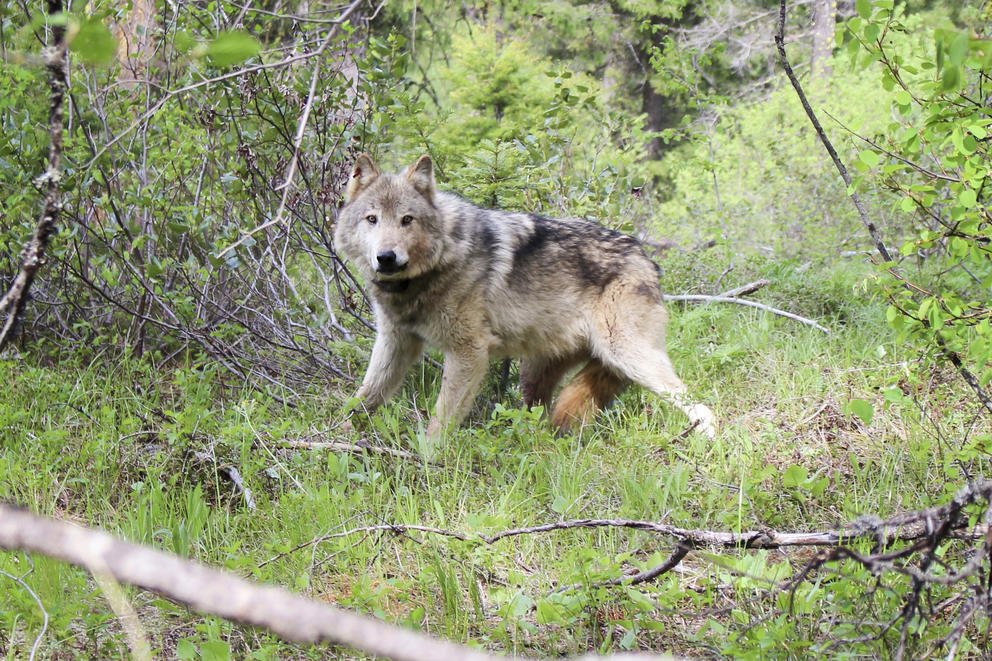As of the end of 2023, Washington had 260 wolves in 42 packs. That’s up from 216 wolves in 37 packs the previous year.
“Recovery is happening right before our eyes,” said Ben Maletzke, statewide wolf specialist at the state Department of Fish and Wildlife.
Maletzke presented the state’s annual wolf report during a Fish and Wildlife Commission meeting on Saturday. The results are likely an undercount because of the difficulty identifying every animal in the state, especially lone wolves without a pack.
The 2023 increase follows steady upward trends since the first Department of Fish and Wildlife survey in 2008. The gray wolf population has grown by an average of 23% every year since then, according to the agency.
The increase has led the agency to consider lowering gray wolves’ protection status from “endangered” to “sensitive” under state law. Environmentalists say the move is premature.
Even if the state makes the policy change, wolves would still be protected in the western two-thirds of Washington under the federal Endangered Species Act.
The Fish and Wildlife Commission is expected to decide on the reclassification in July.
The decision would be another step in the long-controversial management of wolves in Washington since the first breeding pack was confirmed in 2008. Environmentalists say the state is not doing enough to protect the endangered animals, while ranchers say the state is not doing enough to protect their livestock, which wolves can injure or kill.
“The department says reducing wolf protections would show it’s making progress towards recovery, but this report tells a different story,” Amaroq Weiss, a senior wolf advocate at the Center for Biological Diversity, said in a statement.
The annual report shows a continued lack of wolves in Western Washington and fewer breeding pairs than in previous years, she added. Last year, 25 of the state’s wolf packs were considered successful breeding pairs, down one pair from 2022.
Wolf populations have steadily increased in Eastern Washington and the northern Cascades. But Weiss said the state should not consider downlisting wolves until they’ve established territories in other parts of the state where they historically roamed, including from the southern Cascades to the northwest corner of the Olympic Peninsula.
Maletzke said there were signs of wolves gaining more of a foothold in Western Washington last year. One known wolf spent significant time there, likely looking for a mate, and more wolves began to move south of Interstate 90.
“This likely means it is only a matter of time before new packs begin to establish in that recovery region,” Fish and Wildlife Director Kelly Susewind said in a statement.
‘Promising’ wolf/livestock conflict data
Three dozen wolves died across the state in 2023, one fewer than the previous year, according to the report.
Most of those deaths were from legal tribal hunting. Vehicles hit and killed five wolves, a cougar killed one. Another four were killed illegally, and those deaths are still under investigation.
The number of wolves killed following livestock conflicts – one of the most controversial pieces of wolf management – was also down in 2023. In 2022, nine wolves were killed by either the state or ranchers following a conflict with livestock.
According to the 2023 report, only three wolves were killed because of livestock conflicts, two by the state and one by a livestock owner.
Nine of the 42 known wolf packs, about 21%, were involved in at least one confirmed or probable conflict with livestock last year.
“The majority of the packs out there aren’t involved in conflicts even though they overlap with livestock,” Maletzke said. “That’s promising.”
But, he added, that doesn’t come without a cost.
The state estimates it spent more than $1.6 million last year on wolf management. More than $1.3 million of that went to research. The rest pays for lost livestock, lethal removal of wolves, and efforts to prevent wolf/livestock conflicts.
These efforts have kept the number of conflicts with livestock low compared to the population growth over time, Maletzke said.
Washington State Standard originally published this article on April 22, 2024.



